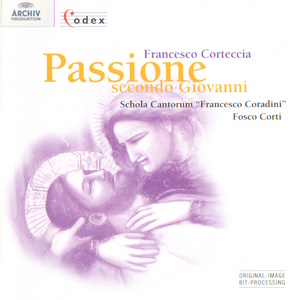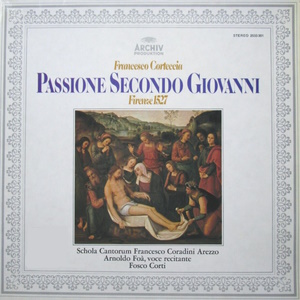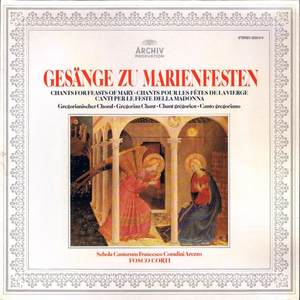 |
|
1 CD -
453 163-2 - (p) 1996
|
|
50
Jahre (1947-1997) - Codex I Serie - 2/10
|
|
|
|
|
|
|
|
| Anonymous |
Antiphonae
Mariae |
|
7' 17" |
|
|
-
Alma redemptoris mater
|
1' 44" |
|
1 |
|
-
Ave regina caelorum
|
1' 28" |
|
2 |
|
-
Regina caeli laetare |
1' 30" |
|
3 |
|
-
Salve regina
|
2' 35" |
|
4 |
| Francesco CORTECCIA
(1502-1571) |
Passione
secondo Giovanni |
|
42' 57" |
|
|
-
Coro: "Passio Domini Nostri Jesu
Christi" |
0' 43" |
|
5 |
|
-
Voce recitante, Coro: "In quel
tempo, Gesù uscì co' discepoli suoi" |
3' 10" |
|
6 |
|
-
Coro: "Ecce vidimus eum non habentem
speciem" |
3' 17" |
|
7 |
|
-
Voce recitante, Coro: "Simon Pietro
seguiva Gesù"
|
3' 00" |
|
8 |
|
-
Coro: "Omnes amici mei dereliquerunt
me"
|
1' 07" |
|
9 |
|
-
Voce recitante, Coro: " Perintanto
menarono Gesù da la casa di Caifa
nel pretorio"
|
1' 30" |
|
10 |
|
-
Coro: "Tristis est anima mea usque
ad mortem" |
3' 09" |
|
11 |
|
-
Voce recitante, Coro: " Adunque
Pilato entrò di nuovo nel pretorio" |
2' 30" |
|
12 |
|
-
Coro: "Vinea mea electa" |
1' 11" |
|
13 |
|
-
Voce recitante, Coro: "Allora Pilato
prese Gesù" |
5' 13" |
|
14 |
|
-
Coro: "Caligaverunt oculi mei a
fletu meo" |
3' 08" |
|
15 |
|
-
Voce recitante, Coro: "Et Gesù,
portando la sua croce" |
2' 52" |
|
16 |
|
-
Coro: "Diviserunt sibi vestimenta
mea" |
0' 54" |
|
17 |
|
-
Voce recitante: "Or presso la croce
di Gesù stavano" |
1' 37" |
|
18 |
|
-
Coro: "Tenebrae factae sunt, dum
crucifixissent Jesum Judaei" |
3' 25" |
|
19 |
|
-
Voce recitante: "I Giudei adunque,
essendo la Parasceve" |
1' 33" |
|
20 |
|
-
Coro: "Post haec autem rogavit
Pilatum Joseph ab Arimathea" |
5' 21" |
|
21 |
|
|
|
|
Arnoldo Foà, voce
recitante (Evangelist)
Schola Cantorum "Francesco
Coradini", Arezzo
Fosco Corti
|
Sources:
Exordium, Turbarum voces, Evangelium:
Florence, Archivio dell'Opera di Santa
Maria del Fiore, Volume di Polifonia
45. fol. 21v-30r
Meditazioni: Responsoria omnia,
Venice, 1570
"Diviserunt sibi": cf. Evangelium,
bars 55-73
Voce recitante: Biblia sacra
tradotta in lingua Thoscana per
maestro Santi Marmochino Fiorentino,
Venice: Giunti, 1538
|
|
|
|
|
Luogo
e data di registrazione |
|
Chiesa
di San Polo, Arezzo (Italia):
- 24-26 aprile 1975 | Anonymous
(1-4)
- 21-23, 25 aprile 1975 |
Corteccia (5-21)
|
|
|
Original
Editions |
|
-
Archiv Produktion | 2533 310 | 1
LP | (p) 1976 | ANA | Anonymous
(1-4)
- Archiv Produktion | 2533 301 | 1
LP | (p) 1975 | ANA | Corteccia
(5-21)
|
|
|
Edizione
"Codex"
|
|
Archiv
Produktion "Codex" | 453 163-2 |
durata 54' 14" | LC 0113 | 1 CD |
(p) 1996 | ADD | stereo
|
|
|
Executive
Producer |
|
Dr.
Andreas Holschneider
|
|
|
Recording
Producer and Tonmeister |
|
Heinz
Wildhagen
|
|
|
Recording
Engineer |
|
Wolf-Dieter
Karwatky
|
|
|
Cover |
|
Giotto
di Bondone "Die Beweinung
Christi", fresco (c.1305); Padua,
Cappella degli Scrovegni
|
|
|
Art Direction
|
|
Fred
Münzmaier
|
|
|
Note |
|
Original-Image-Bit-Processing
- Added presence and brilliance,
greater spatial definition |
|
|
|
|
|
ORIGINAL
EDITIONS

1 LP - 2533 301 - (p) 1975
 1 LP - 2533 310 -
(p) 1976
1 LP - 2533 310 -
(p) 1976
|
Treasures
from Archiv Produktion’s
Catalogue
A rare and valuable collection of
documents is the pride of any
library or archive. CODEX, Archiv
Produktion’s new series, presents
rare documents in sound from 50
years of pioneering recording.
These recordings have been
digitally remastered using
original-image bit-processing
technology and can now be
appreciated in all the richness of
their original sound-image. They
range from the serene counterpoint
of a Machaut, the intensely
spiritual polyphony of a Victoria,
to the imposing state-music of a
Handel.
For the artists on Archiv
Produktion recordings, a constant
aim has been to rediscover the
musical pulse of past times and to
recreate the spirit of past ages.
In this sense each performance
here - whether by Pro Musica
Antiqua of Brussels in the 1950s,
the Regensburg Domchor in the
1960s, or Kenneth Gilbert and
Trevor Pinnock in the 1970s - made
a vital contribution to the
revival of Early Music in our
time.
CODEX highlights recordings that
were unique in their day, many of
them first recordings ever of this
rare and remarkable repertoire,
now appearing for the first time on
CD. A special aspect of the
history of performance in our
century can now be revisited, as
great moments from Archiv
Produktion’s recording history are
restored and experienced afresh.
Dr.
Peter Czornyi
Director,
Archiv Produktion
CORTECCIA: ST JOHN PASSION
Francesco Corteccia was born in
Florence on 27 July 1502, and died
there on 7 June 1571. After
serving as a chorister at the
Church of Saint John the Baptist
(the present Baptistery in
Florence) he became a priest in
1526. A pupil of Bartolomeo
degl’Organi for keyboard
instruments and Bernardo Pisano
for composition, he was organist
at the Church of San Lorenzo
(1531) and later, chapel master
(from 1540 until his death) at
Florence Cathedral and the Oratory
of St. John, and also at the
Medici court under the patronage
of Duke Cosimo I. A reputable
composer of madrigals, intermedi,
mascherate, motets,
lamentations, responses, passions,
hymns, etc., he must be considered
as the most valid link between the
end of the golden era of the
Florentine carnival songs and the
beginning of the Bardi Camerata.
According to precise statements by
the composer, the Passion of
Christ according to St. John
was completed in 1527 - maybe in
the last two months of that year
so critical for the city of
Florence, afflicted by political
agitation and a violent plague
epidemic. To those who know
Corteccia’s personality well, it
is not surprising that his very
first ambitious work should have
been music for a setting of the
celebrated Gospel of St. John. For
throughout his life, the
Florentine master was always to
show a special love, a genuine
predilection for the sacred texts
connected with the liturgical
ceremonies of Holy Week, achieving
the finest results when the sense
of drama becomes sharper and
deeper in the words. And so the
two Passions (the St.John and the
St. Matthew), the earliest
examples of the polyphonic Passion
literature of the Italian
Renaissance were soon joined by
the massive Lamentations of
Jeremiah (translated into
the “Florentine tongue”, and
therefore lost after the Council
of Trent), the Responsoria,
Psalm 50 (in three
versions), the Canticle of
Zechariah (also in three
versions) and all the minor works
which complete the Holy Office for
the three days of Easter.
Corteccia wrote for male chorus,
divided into four parts, the
“Turbarum voces”, in other words,
all the statements that the
evangelist attributed to the crowd
hostile to Jesus (the so-called
“Multiloquentes”). Besides these
sections, the composer set in
four-part polyphony the “Exordium”
and the vast final part of the
Passion (“Evangelium”) - which is
generally omitted and narrates the
deposition of Christ from the
Cross and his burial. The
polyphonic pages which Francesco
Corteccia has left us for the Passion
therefore correspond to the
typical formal style of early
polyphonic treatment of the text
of the historiae recorded
by the four evangelists. The solo
parts, however, remain tied to
emphatic Gregorian declamation
(“accentus”). These are, the Chronista,
whose task is narration in the
third person of the events and who
links the entrances of the various
characters, Christus and
the Soliloquentes of the
“Synagoque” (the latter including
all the accusers of Jesus). But in
Florence before the
Counter-Reformation - especially
between 1515 and 1545 (evidently
in the wake of the successful
experiences of the medieval
Passion Play) - performances took
place also outside the liturgical
service and therefore away from
churches. And this came about from
the time when, through “the
elevation of the soul” (“elevatione
dell’anima”), the surviving
associations of authors of laudi
(among them the one known as
Compagnia di S. Maria delle Laude
with which Corteccia had direct
and profitable connections) during
the Easter period favoured the
plain “narratione divota delle
Passioni” (devout narration of the
Passion), with the Holy Scripture
“faithfully translated into
Florentine” (so that the people
might understand exactly and
immediately), reserving Latin
exclusively for the “passages
given over to music”. In this
respect, the most interesting
point is to know the origin of the
usage - “the interruption of the
narration at suitable places, in
order to allow the musicians to
sing” various texts - not inherent
to that of the Passion. Generally
these were laudi sung in
the vernacular or, more frequent,
responsories for the Easter triduum
- “inspired by the great torment
of our Lord God on the Cross”, as
“devout meditations". In this
field, certainly favourable to the
natural inclinations of the young
maestro, Corteccia showed
himself to be a true and convinced
champion of the clearly-defined
drama, capable of creating for the
“devout common people” a sincere,
in some cases, violent impression
- for people who were in no way
learned and for whom the
associations of lauda
authors catered.
Corteccia uses a simple, linear
style, featuring effective and
skilful chordal patterns of
masculine sobriety and vigorous
expressive power, not yielding to
the urge, at the time very much in
fashion and of great importance,
to display bravura counterpoint at
every opportunity. Following the
isorhythmic polyphonic songs of
the people in the late 15th and
early 16th century, Corteccia is
revealed here as a “harmonist” of
rare sensitivity, carefully
selecting consonances and
dissonances both in order to
ensure comprehension of the words
of the text, and set them in the
most apt atmosphere to the
particular dramatic moment.
Thus, in complete contrast to the
solemn religiosity of the
“Exordium” are the vehement
entries of the “Turbarum voces” -
rapid but complete dramatic
miniatures which, according to
clearly-defined psychological
impulses, from time to time assume
different characteristics, even in
their common, simple writing. The
impetuous force of the “Turbae” is
interrupted by the sweet pietàs
ofthe seven Meditations (six
responsories and an antiphon for
Holy Week) - which include genuine
masterpieces of the genre,
“Tristis est anima mea”,
“Caligaverunt oculi mei”, and in
particular, the wonderful
“Tenebrae factae sunt”, dying away
in the long final page of the
“Evangeliurn”, where the static
quality in the isorhythmic flow of
the voices with its anguished,
rhythmic movement, punctuated by
frequent silences makes it
admirably apt as the final choral
prayer of a redeemed multitude
who, after demanding the death
sentence for the Innocent, now
intend to accompany Jesus to the
tomb in a sad, desolate procession
of penitence.
Mario
Fabbri (1975)
(Translation:
Gwyn Morris)
MARIAN ANTIPHONS
The second component of the
Catholic liturgy is the Office or
Hours celebrated at set daily
times (Officium). Among its
constituent musical elements, the
antiphons and responsories, the
Marian texts abound in references
to the mysteries they celebrate.
Yet from the 12th century onwards,
four Marian antiphons have
received especial distinction;
divorced from their psalm
connections they have functioned
cyclically within the church year
as self-containing closing chants
for the separate Hours.
Alma
redemptoris mater.
Celebrated from Advent
to Candlemas (2 February). The
text is ascribed to the monk and
poet Heriman the Lame from
Reichenau (Hermannus Contractus,
died 1054). The melody with its
extensive initial melisma bears
all the characteristics of a
12th-century composition.
Ave regina caelorum.
Celebrated from Candlemas to
Wednesday in Holy Week. The
rhyming text and its musical
setting (probably of French
origin) suggest a miniature
sequence: (1) Double versicle:
Ave... / Ave... (2) Double
versicle: Salve... /
Gaude... Conclusion: Vale...
Regina caeli.
Celebrated from Easter Sunday to
Friday after Pentecost. The
melismata, uncharacteristic of an
antiphon, betray the new spirit
which had penetrated even
liturgical melodic forms at the
end of the 11th century.
Salve regina (mater)
misericordiae.
Celebrated during the remainder of
the church year. Here the
restless, jaggedly oscillating
melody betrays the new style which
characterises secular and sacred
music-making during the prolific
decades of the 12th century.
Bruno
Stäblein (1976)
(Translation.Jennifer
Parker)
|
|
|
|